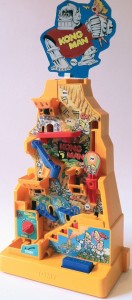 Kongman was very similar to Screwball Scramble in that you had to get a ball bearing from one end of the course to the other, the main differences with Kongman was that the game was played vertically rather than flat and that it only made use of one button.
Kongman was very similar to Screwball Scramble in that you had to get a ball bearing from one end of the course to the other, the main differences with Kongman was that the game was played vertically rather than flat and that it only made use of one button.
Released in 1982, two years after Screwball Scramble had been released, Kongman never quite reached the same levels of popularity, while the idea was a good one and the game is fun, it was let down by its need for batteries which Screwball Scramble didn’t require.
The game was actually probably more challenging than Screwball Scramble and had much more going on. The aim of the game was simply to get the ball bearing to the top of the tower before the timer ran out. Beating all the obstacles along the way.
Kongman Obstacles
MOVING STEPS
The first obstacle is four steps which move up and down. This was fairly easy as you simply had to wait for the steps to do the work for you.
Bridge
The bridge had a split in the middle and as one side moved up the other side moved down. You needed perfect timing to get the ball bearing across the bridge to the other side.
MAGNETIC SWING
Once you had hopped up from the bridge you would need to press the button to jump up and attach yourself to the magnetic crane. The crane then swung around and dropped you in a different location.
BALLOON RIDE
The balloon basket moved up and down on its own. This meant you had to wait for the perfect time before you pushed the button to get the ball bearing inside. The ball bearing then went up in the balloon and was dropped through a tunnel.
MAGNETIC WALL
Once the ball came out of the tunnel it would land in a tray and tilt you down to the magnetic wall. From there the ball bearing would travel up the wall by itself. At the top of the wall it would drop you in a tray, ready for the final obstacle.
SWINGING KONGMAN
The final obstacle was a magnet attached to a cardboard cut-out of Kongman at the top of the course. It moved around in 360 degree circles, when the time was right you hit the button to make the ball jump and attach to the magnet.
The ball bearing would swing around with the magnet and drop into a hole. The ball would then fall back to the bottom of the course, ready for you to go again.
